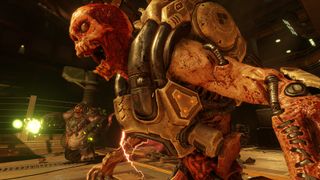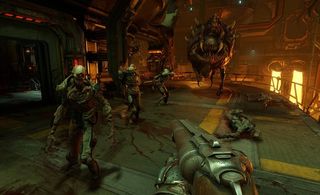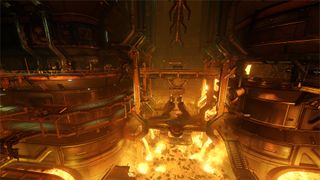Doom is the most cerebral slaughterhouse you've ever seen
Do not confuse Doom for some semi-ironic throwback to the big dumb shooters we all (think we) remember from the ‘90s. Do not assume that Doom’s fast, ferocious focus on brutality, bullets, and bone-snappping takedowns indicates some cheap rallying cry to the anti-CoD, ‘old school’-worshipping curmudgeons. Doom is not a gimmick. Doom is not a mindless tribute to a bygone era. Doom is an intricate, polished, and aggressively tuned-up machine, with intelligent and purposeful design underpinning every whirling mechanism and furious combustion.

Take the multiplayer, for instance. Yes, it might look like a ludicrous, carefree free-for-all, with its speed, its jump-pads, and its shotguns that turn man to airborne mince with a single squeeze of the trigger. The relentless pace, constant killing, and intermittent facility to morph into a giant, rocket-slinging, flying goddamn demon might make it appear one-note. But in truth it’s a cleverer, more involved, more strategically demanding shooter than you’ve played in years.
It’s the health packs that do it. With no regeneration of vitality available, your sole means of recovery and recommencement after a skirmish is in the multitudinous med-kits that litter the map. They get hoovered up quickly, but they replenish quickly too. And they are your everything.
They need to be at the forefront of your mind, always, way above the running, the jumping, the guns and the killing. At every moment, you need to be aware of your quickest route to health. Before engaging any opponent, you must know how much damage you can take and how soon you can recover from it, if at all. You need to know when to press a fight, and precisely when to peel away to fight another day. You must know that self-preservation is the key to effective aggression, and that on-the-fly medical treatment must underpin every single move you make.

It’s a masterclass in tactical spatial awareness, exacerbated by Doom’s layered, winding, rabbit-warren design of secret routes, shortcuts, and hidden high-ground. And that’s before you even get into the vast array of weapon strategy afforded by each gun’s secondary mode, attached to L1 or the left trigger, and replacing traditional iron-sights. The Plasma Rifle might be a great tool for spamming groups with, but if you combine its lingering, area-of-effect goo shot with the Super Shotgun’s close-range immediacy, you have a set-up of near peerless location control.
And campaign is no less intelligent in its onslaught. Take Doom’s wildly varied, multi-class bestiary of monsters. Far from the feral meat you might expect, they’re actually more akin to chess pieces. Every one has specific purpose and intent in its abilities. Every one presents a particular kind of problem. And once you start multiplying those problems by each other in group encounters – the whole gory show amplified by Doom’s level design, which plays on line-of-sight but features no safe cover opportunities - you have gunplay that, while never for a split-second losing its immediacy and brutal gratification, ascends to be legitimately described by its devs as a “combat puzzle”.
Again, it’s those health packs that do it, at least in part. Deal out enough damage to any particular enemy, and they’ll enter a staggered state, in which they can be rudely accosted for one of Doom’s hilariously excessive ‘Glory Kill’ takedowns. Legs will be snapped off and beaten into skulls. Skulls will be torn in half to leave tongues dangling. Extra health and ammo will be spewed from collapsing corpses. All of which, most importantly, leads to a very specific pace, flow and focus – almost a musicality – in Doom’s combat, the set-up and execution of those stand-out kills becoming centrepieces within battles.
Sign up to the 12DOVE Newsletter
Weekly digests, tales from the communities you love, and more

They need to be fueled and reaped on a regular basis in order to maintain momentum (momentum is the cornerstone of the entire game; if you stop moving, you’re dead) the order and route by which you dismantle each puzzle box making no small impact on how well that turns out. Not that Doom is at all prescriptive. The game’s AI, overall pace and consistent aggression are more than enough to ensure a reactive, ever-changing ecosystem, even during repeated sections.
And those Glory Kills don’t just hand out life-sustaining trinkets. They also deal out points that can be spent on character customisation. Delivering tweaks to abilities and game behaviour akin to small mods, these player-chosen changes can add things like bigger ammo drops, faster dismemberments, or even speed boosts in reward for executions. It’s hardly likely to turn Doom into Mass Effect – this is a good thing, of course – but the friendly, extra layer of malleability, in sympathy to personal play-styles, is a very welcome and unexpected bit of creativity.
Speaking of which, it’s vital that I talk some more about SnapMap. A level editor of marvellous power and accessibility, while it doesn’t currently look to rival bona fide modding for versatility, it certainly appears a match for console gaming’s reigning top purveyor of user-generated design. Imagine LittleBigPlanet with a bloody FPS interface rather than charmingly twee platforming, and you have the rough idea.

Built around the usage of pre-set architectural pieces, SnapMap nonetheless allows the modification of a raft of variables within them, with logic systems and enemy placements able to deliver everything from scripted rollercoaster rides, to custom cutscenes, to previously unheard-of multiplayer modes. But of course, as LBP has exemplified, the real power of any video game level editor is not in how well it delivers fresh spins on the main game, but in how adept it is at facilitating content that utterly flies in the face of the source material’s genre. SnapMap is already churning out tower defense and non-violent memory test quizzes. It almost certainly has a long and ludicrously productive life ahead of it.
As, I suspect, has Doom overall. Because while anyone can grab short-term attention with a bit of noise, fury, and extravagance, real substance – and the engaging, long-tail relevance that comes with it – requires real intelligence and depth. And at the moment, Doom looks to have that by the absolute pit full.
